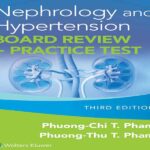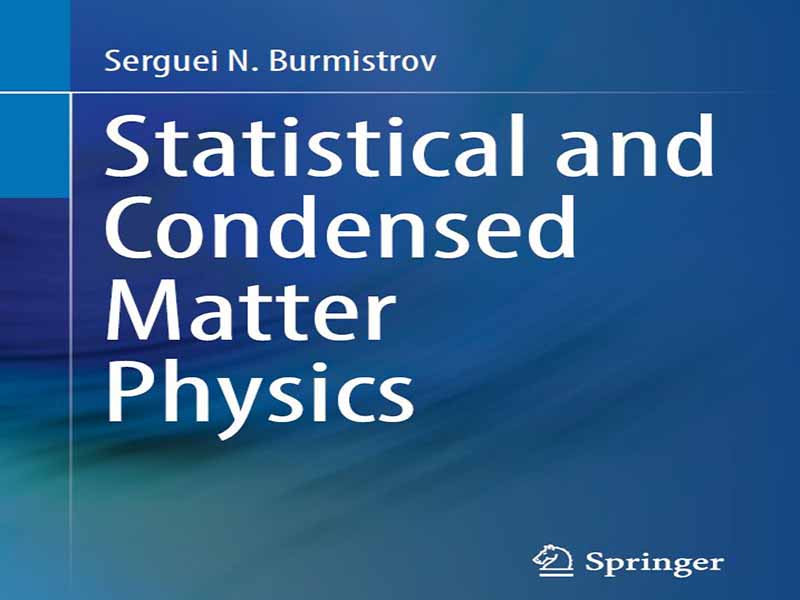- عنوان کتاب: Statistical and Condensed Matter Physics
- نویسنده: Serguei N. Burmistrov
- حوزه: فیزیک آماری
- سال انتشار: 2025
- تعداد صفحه: 382
- زبان اصلی: انگلیسی
- نوع فایل: pdf
- حجم فایل: 3.28 مگابایت
موضوع فیزیک آماری مطالعه خواص فیزیکی و رفتار سیستمهای ماکروسکوپی مختلف و محیطهای چگال تحت تعادل ترمودینامیکی (گرمایی) است. تعادل ترمودینامیکی یا گرمایی نشان میدهد که سیستم فیزیکی را میتوان به طور کامل با توزیع گیبس متعارف توصیف کرد. مشکل اصلی که در اینجا پیش میآید محاسبه تابع پارتیشن و پتانسیل ترمودینامیکی مربوطه است. در حال حاضر، فیزیک آماری اساس فیزیک ماده چگال و ابزاری برای مطالعه انواع محیطهای چگال است. محیط چگال یا سیستم ماکروسکوپی معمولاً به عنوان یک سیستم فیزیکی متشکل از تعداد ماکروسکوپی ذرات و داشتن تعداد ماکروسکوپی درجات آزادی درک میشود. در اصل، اصطلاح ماکروسکوپی، به طور ضمنی به معنای گذار محدودکننده به سیستم بینهایت است که مثلاً تعداد نامتناهی ذرات یا حجم دارد. در عین حال، سیستم فیزیکی به خودی خود میتواند یک ذره واحد را نشان دهد اما با حمام حرارتی ماکروسکوپی در تعامل باشد. به عنوان نمونهای معمول از محیطهای چگال، میتوانیم از گازها، مایعات معمولی و ابرشاره، جامدات بلوری و آمورف، ابررساناها و آهنرباهای مختلف نام ببریم. نقطه شروع در مطالعه ماده چگال، معرفی و تعیین کمیتهای ترمودینامیکی لازم بسته به نوع سیستم فیزیکی مورد بررسی است. به عنوان مثال، این کمیتها میتوانند دما، حجم، فشار، قطبش، مغناطش و پتانسیلهای ترمودینامیکی به عنوان توابعی از این کمیتها، مانند انرژی، انرژی آزاد و آنتروپی باشند. فیزیک آماری یکی از سه دوره اصلی فیزیک نظری است که دانشجویان موسسه فیزیک و فناوری مسکو آن را مطالعه میکنند. در طول 50 سال گذشته، فیزیک آماری و فیزیک ماده چگال به سرعت در زمینه علمی توسعه یافته و به موفقیتهای چشمگیری، به ویژه به دلیل توسعه و استفاده از مدلها و روشهای ریاضی خاص، دست یافتهاند. مورد دوم اغلب بسیار پیچیده به نظر میرسد، نیاز به محاسبات دست و پا گیر دارد و ممکن است بدون آموزش ریاضی ویژه به سادگی غیرقابل دسترسی باشد. با این حال، این موفقیتهای فیزیک آماری و فیزیک ماده چگال هنوز بازتاب قابل دسترس و کاملی در کتابهای درسی پیشنهادی برای دانشجویان رشتههای فیزیک پیدا نکرده است. ظاهراً این امر ممکن است به دلایل زیر مرتبط باشد. اولاً، لازم است مطالب با استفاده از سادهترین دستگاه ریاضی به دانشجویان منتقل شود. دوم، محدودیت زمانی است که به مطالعه این موضوع اختصاص داده شده است. در حال حاضر، موسسه فیزیک و فناوری مسکو، برخلاف دوره سالانه مکانیک کوانتومی، یک ترم واحد برای مطالعه درس فیزیک آماری دارد. این به دلیل گستردگی موضوع فیزیک آماری و ماده چگال، بدیهی است که کافی نیست. بنابراین، لازم است الزامات انتخاب محتوای آموزشی که دانشجویان دانشگاههای فیزیک باید در یک دوره ترم واحد مطالعه کنند، افزایش یابد. شیوه تدریس درس فیزیک آماری مرا به موارد زیر سوق داده است. محتوایی که مربوط به اصول، گزارههای اساسی فیزیک آماری و خواص گازهای ایدهآل کلاسیک و کوانتومی است، هیچ مشکلی برای دانشجویان MIPT ایجاد نمیکند. مشکلات یادگیری، تعداد قابل توجهی از دانشجویان را هنگام شروع مطالعه خواص فیزیکی سیستمهای کوانتومی غیر ایدهآل و محیطهای چگال، نگران خواهد کرد، زیرا این امر مستلزم درک مدلهای فیزیکی پیچیدهتر و کاربرد ابزارهای ریاضی پیچیدهتر است. هدف از کتاب درسی حاضر، کمک به دانشجویان، فیزیکدانان آینده، برای تسلط بر عناصر اساسی فیزیک آماری و یادگیری نحوه به کارگیری روشهای آن در عمل است. برای درک محتوای کتاب، کافی است با مفاهیم اساسی فیزیک آماری در بدنه دروس فیزیک عمومی مرسوم آشنا باشید. نویسنده هنگام نگارش کتاب با مشکلاتی در رابطه با حجم معقول متن و بنابراین، با ضرورت انتخاب محتوای واقعی از میان تعداد زیادی پدیده فیزیکی جالب در محیطهای چگال مواجه شد. در اینجا، ترجیحات شخصی و تجربه کاری نویسنده در این زمینه از فیزیک و همچنین دیدگاه او از فیزیک آماری به عنوان بخش ضروری از دوره کامل فیزیک نظری نمایش داده شده است. ساختار کتابی که به خواننده پیشنهاد میشود، از محتوای آن به راحتی قابل درک است. در چند کلمه، نویسنده میتواند بگوید که این کتاب هم به قوانین اساسی فیزیک آماری و هم به جالبترین پدیدههای فیزیکی که در محیطهای چگال رخ میدهند، اختصاص دارد. کتاب با توضیح اصول اساسی فیزیک آماری بر اساس توزیع گیبس متعارف و ارتباط آنها با قوانین ترمودینامیک کلاسیک آغاز میشود. در ادامه، خواص ترمودینامیکی محیطهای غیر برهمکنشی که نمایانگر توزیع کلاسیک (بولتزمن) هستند، در نظر گرفته میشوند…
The subject of statistical physics is to study the physical properties and behavior of various macroscopic systems and condensed media under the thermodynamic (heat) equilibrium. The thermodynamic or heat equilibrium implies that the physical system can wholly be described by the canonical Gibbs distribution. The main difficulty that arises here is to calculate the partition function and corresponding thermodynamic potential. At present, statistical physics is the basis of condensed matter physics and the tool for studying a variety of condensed media. The condensed medium or macroscopic system is usually understood as a physical system consisting of the macroscopic number of particles and having the macroscopic number of degrees of freedom. In essence, the term, macroscopic, implies implicitly the limiting transition to the infinite system having, for example, an infinite number of particles or volume. At the same time, the physical system in itself can also represent a single particle but interacting with the macroscopic thermal bath. As a typical example of condensed media, we can mention gases, normal and superfluid liquids, crystalline and amorphous solids, superconductors, and various magnets. The starting point in the study of condensed matter is the introduction and determination of the necessary thermodynamic quantities depending on the type of the physical system to be explored. For example, this may be temperature, volume, pressure, polarization, magnetization, and thermodynamic potentials as functions of these quantities, e.g. energy, free energy, and entropy. The statistical physics is one of three main courses of theoretical physics which students of Moscow Institute of Physics and Technology study. Over the past 50 years, statistical physics and condensed matter physics have developed rapidly in the scientific context and have achieved outstanding success due, in particular, to the development and usage of specific models and mathematical methods. The latter often turns out to be very complicated, requires cumbersome calculations, and may simply be inaccessible without special mathematical training. However, these successes of statistical physics and condensed matter physics have not yet found an accessible and complete reflection in the textbooks proposed for the students of physical specialties. Apparently, this may be associated with the following reasons. Firstly, it is necessary to convey the material to students, using the simplest mathematical apparatus. Secondly, it is the limited time frame that is assigned to studying the subject. Currently,MoscowInstitute of Physics and Technology, in contrast to the annual course of quantum mechanics, has a single semester for studying the statistical physics course. This is obviously insufficient due to the extent of the subject of statistical and condensed matter physics. Thus, it is necessary to enhance the requirements for selecting the instructional content that students of physical universities should study under single semester course. The practice of teaching the statistical physics course has led me to the following. The content that relates to the principles, basic statements of statistical physics, and properties of classical and quantum ideal gases poses no difficulties for the MIPT students. The learning problems will concern a noticeable amount of students when they start to study the physical properties of non-ideal quantum systems and condensed media since this requires a comprehension of more complicated physical models and application of more sophisticated mathematical tools. The purpose of the present textbook is to help the students, future physicists, to master the basic elements of statistical physics and learn how to apply its methods in practice. For understanding the content of the book, it is sufficient to be familiar with the basic concepts of statistical physics in the body of conventional general physics courses. When writing the book, the author came across some difficulties associated with the reasonable text volume and, therefore, with the necessity to select the actual content from the numerous number of interesting physical phenomena in condensed media. Here the author’s personal preferences and work experience in this field of physics are displayed as well as his viewpoint of statistical physics as a necessary part of the full course of theoretical physics. The structure of the book proposed to the reader is easy to understand from its contents. In a few words, the author can say that the book is devoted both to the fundamental laws of statistical physics and to most interesting physical phenomena occurring in condensed media. The book begins with explaining the basic principles of statistical physics based on the canonical Gibbs distribution and their connection with the laws of classical thermodynamics. Next, the thermodynamic properties are considered of non-interacting media representing classical (Boltzmann) ideal gases and quantum Fermi and Bose ideal gases. This section concludes with the thermal properties of black radiation and solid crystals. The next section is devoted to the thermodynamic fluctuations, various phase transitions in the mean-field approximation, and basics of critical phenomena with the approximate calculation of critical indices.
این کتاب را میتوانید از لینک زیر بصورت رایگان دانلود کنید:
Download: Statistical and Condensed Matter Physics



































نظرات کاربران